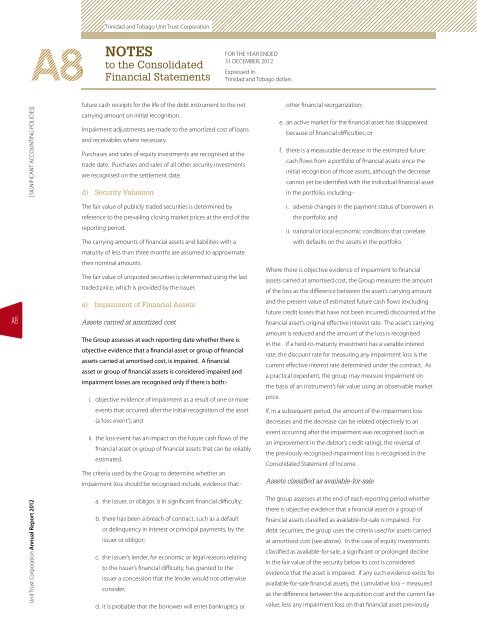p17n63qg7jmbh1r4fin71pds1p454.pdf
You also want an ePaper? Increase the reach of your titles
YUMPU automatically turns print PDFs into web optimized ePapers that Google loves.
A8<br />
A8<br />
| SIGnIFICAnT ACCOUnTInG POLICIES|<br />
Unit Trust Corporation Annual Report 2012<br />
Trinidad and Tobago Unit Trust Corporation<br />
Notes<br />
to the Consolidated<br />
Financial Statements<br />
future cash receipts for the life of the debt instrument to the net<br />
carrying amount on initial recognition.<br />
Impairment adjustments are made to the amortized cost of loans<br />
and receivables where necessary.<br />
Purchases and sales of equity investments are recognised at the<br />
trade date. Purchases and sales of all other security investments<br />
are recognised on the settlement date.<br />
d) security valuation<br />
The fair value of publicly traded securities is determined by<br />
reference to the prevailing closing market prices at the end of the<br />
reporting period.<br />
The carrying amounts of financial assets and liabilities with a<br />
maturity of less than three months are assumed to approximate<br />
their nominal amounts.<br />
The fair value of unquoted securities is determined using the last<br />
traded price, which is provided by the issuer.<br />
e) Impairment of financial assets<br />
Assets carried at amortized cost<br />
The Group assesses at each reporting date whether there is<br />
objective evidence that a financial asset or group of financial<br />
assets carried at amortised cost, is impaired. A financial<br />
asset or group of financial assets is considered impaired and<br />
impairment losses are recognised only if there is both:-<br />
i. objective evidence of impairment as a result of one or more<br />
events that occurred after the initial recognition of the asset<br />
(a ‘loss event’); and<br />
ii. the loss event has an impact on the future cash flows of the<br />
financial asset or group of financial assets that can be reliably<br />
estimated.<br />
The criteria used by the Group to determine whether an<br />
impairment loss should be recognised include, evidence that:-<br />
a. the issuer, or obligor, is in significant financial difficulty;<br />
b. there has been a breach of contract, such as a default<br />
or delinquency in interest or principal payments, by the<br />
issuer or obligor;<br />
c. the issuer’s lender, for economic or legal reasons relating<br />
to the issuer’s financial difficulty, has granted to the<br />
issuer a concession that the lender would not otherwise<br />
consider;<br />
d. it is probable that the borrower will enter bankruptcy or<br />
FOR THE YEAR ENDED<br />
31 DECEMBER, 2012<br />
Expressed in<br />
Trinidad and Tobago dollars<br />
other financial reorganization;<br />
e. an active market for the financial asset has disappeared<br />
because of financial difficulties; or<br />
f. there is a measurable decrease in the estimated future<br />
cash flows from a portfolio of financial assets since the<br />
initial recognition of those assets, although the decrease<br />
cannot yet be identified with the individual financial asset<br />
in the portfolio, including:-<br />
i. adverse changes in the payment status of borrowers in<br />
the portfolio; and<br />
ii. national or local economic conditions that correlate<br />
with defaults on the assets in the portfolio.<br />
Where there is objective evidence of impairment to financial<br />
assets carried at amortised cost, the Group measures the amount<br />
of the loss as the difference between the asset’s carrying amount<br />
and the present value of estimated future cash flows (excluding<br />
future credit losses that have not been incurred) discounted at the<br />
financial asset’s original effective interest rate. The asset’s carrying<br />
amount is reduced and the amount of the loss is recognised<br />
in the . If a held-to-maturity investment has a variable interest<br />
rate, the discount rate for measuring any impairment loss is the<br />
current effective interest rate determined under the contract. As<br />
a practical expedient, the group may measure impairment on<br />
the basis of an instrument’s fair value using an observable market<br />
price.<br />
If, in a subsequent period, the amount of the impairment loss<br />
decreases and the decrease can be related objectively to an<br />
event occurring after the impairment was recognised (such as<br />
an improvement in the debtor’s credit rating), the reversal of<br />
the previously recognised impairment loss is recognised in the<br />
Consolidated Statement of Income.<br />
Assets classified as available-for-sale<br />
The group assesses at the end of each reporting period whether<br />
there is objective evidence that a financial asset or a group of<br />
financial assets classified as available-for-sale is impaired. For<br />
debt securities, the group uses the criteria used for assets carried<br />
at amortised cost (see above). In the case of equity investments<br />
classified as available-for-sale, a significant or prolonged decline<br />
in the fair value of the security below its cost is considered<br />
evidence that the asset is impaired. If any such evidence exists for<br />
available-for-sale financial assets, the cumulative loss – measured<br />
as the difference between the acquisition cost and the current fair<br />
value, less any impairment loss on that financial asset previously



